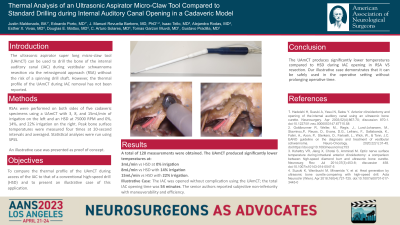Ultrasonic Aspirator Micro-claw Tool: a Safe Novel Instrument to Perform Internal Auditory Canal Opening
Ultrasonic Aspirator Micro-claw Tool: A Safe Novel Instrument to Perform Internal Auditory Canal Opening
Friday, April 21, 2023


Justin Maldonado, BA (he/him/his)
Research Fellow
Emory University
Cumming, Georgia, United States
ePoster Presenter(s)
Introduction: The retrosigmoid approach (RSA) for vestibular schwannomas (VS) often requires intradural drilling to access the internal auditory canal (IAC), potentially resulting in thermal and direct injury to neurovascular structures. The ultrasonic aspirator micro-claw tool (UAmCT) can be used to open the IAC, however, its thermal profile has not been reported. The aim of this study is to compare the thermal profile of the UAmCT during access of the IAC to that of conventional high-speed drills.
Methods: A RSA was performed on one side of two embalmed cadaveric specimens. The IAC was opened with the UAmCT in specimen 1 under 3mL/min and 15 mL/min of irrigation, while a high-speed drill (HSD) at 75000RPM was used in specimen 2 with 0% irrigation and then 22% irrigation. Bone surface temperatures were measured in four 20-second intervals with the peak bone temperature being recorded. An illustrative case of a VS resected via a RSA using the UAmCT to access the IAC is presented.
Results: The IAC was opened without dural violations or neurovascular injury with both the UAmCT and the HSD. The mean peak bone temperature was 39.5+/-1.3ᵒC and 26.5+/-1.2ᵒC under 3mL/min and 15mL/min irrigation, respectively, using UAmCT. The mean peak bone temperatures were 83+/-3.4ᵒC and 33+/-4.2ᵒC under 0% and 22% irrigation, respectively, using HSD. The UAmCT and the use of irrigation, as independent variables, produce significantly lower temperatures when compared to the HSD and no irrigation (p < 0.029). UAmCT in combination with 15mL/min irrigation produces the lowest temperature. In the illustrative case, operating time was not prolonged by the use of the UAmCT.
Conclusion : The UAmCT can potentially reduce the risk of thermal injury to neurovascular structures, intradural bone dust dispersion, and the risks connected to spinning tools. Thus, the UAmCT may be a safe and effective alternative to HSD for IAC opening during VS resection.
Methods: A RSA was performed on one side of two embalmed cadaveric specimens. The IAC was opened with the UAmCT in specimen 1 under 3mL/min and 15 mL/min of irrigation, while a high-speed drill (HSD) at 75000RPM was used in specimen 2 with 0% irrigation and then 22% irrigation. Bone surface temperatures were measured in four 20-second intervals with the peak bone temperature being recorded. An illustrative case of a VS resected via a RSA using the UAmCT to access the IAC is presented.
Results: The IAC was opened without dural violations or neurovascular injury with both the UAmCT and the HSD. The mean peak bone temperature was 39.5+/-1.3ᵒC and 26.5+/-1.2ᵒC under 3mL/min and 15mL/min irrigation, respectively, using UAmCT. The mean peak bone temperatures were 83+/-3.4ᵒC and 33+/-4.2ᵒC under 0% and 22% irrigation, respectively, using HSD. The UAmCT and the use of irrigation, as independent variables, produce significantly lower temperatures when compared to the HSD and no irrigation (p < 0.029). UAmCT in combination with 15mL/min irrigation produces the lowest temperature. In the illustrative case, operating time was not prolonged by the use of the UAmCT.
Conclusion : The UAmCT can potentially reduce the risk of thermal injury to neurovascular structures, intradural bone dust dispersion, and the risks connected to spinning tools. Thus, the UAmCT may be a safe and effective alternative to HSD for IAC opening during VS resection.
